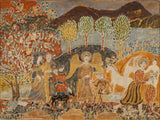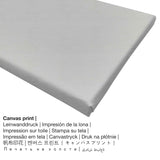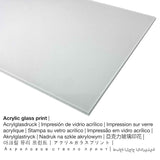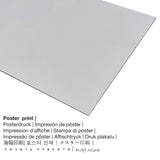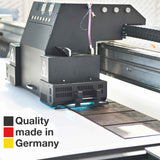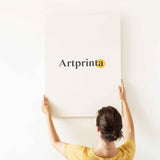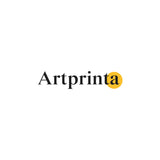Charles Prendergast, 1917 - Ndị mmụọ ozi - mbipụta nka mara mma
Ụtụ gụnyere. Mbupu gbakọrọ na ndenye ọpụpụ.
The nkà nke oge a ihe omimi ndị mmụọ ozi e sere ya Charles Prendergast. Emere ụdị nke masterpiece na oke zuru oke: Overall (with engaged frame): 25 1/2 x 33 1/2 in (64,8 x 85,1 cm) e tekwara ya na ọkara tempera, graphite, silver and gold leaf on carved, incised gessoed panel. Today, the artwork belongs to the Barnes Foundation's art collection. With courtesy of Site n'ikike nke Barnes Foundation, Merion na Philadelphia, Pennsylvania (ikike - ngalaba ọha).Furthermore, the artpiece has the following creditline: . Furthermore, alignment of the digital reproduction is in landscape format ya na oke akụkụ nke 4: 3, nke pụtara na ogologo bụ 33% ogologo karịa obosara.
Ozi izizi gbasara ihe osise sitere na ụlọ ngosi nka (© Nwebiisinka - site na Barnes Foundation - www.barnesfoundation.org)
Charles Prendergast, Maurice's younger brother, was a unique artist-craftsman whose medium of expression set him apart from other artists of his generation. He began making gessoed panels in 1912. The first compositions were based on religious themes and prototypes. Despite the Christian imagery, the pictorial sources for Charles's panels are found in a broad range of Eastern and Western traditions—Persian, Chinese, Byzantine, Egyptian, Coptic, Roman, and Etruscan—which he freely interpreted according to his "fancy". The technique known as japanning, a specialty of some 18th-century Boston cabinetmakers, was another important source for the artist. Japanning was a Western imitation of oriental lacquer work in which figures were modeled in low relief in gesso, with metal (silver and/or gold leaf) subsequently applied on a black or red painted background. Prendergast's own technique was characterized in 1919:"The method employed by Mr. Prendergast in making these panels differs somewhat from the tradition. It is more than merely a flat painting and gilding on plaster. The wood he rises is the sugar pine, or, where possible to procure, fine old white pine. On the surface the outline of his cartoon is transferred with charcoal, and the deeper lines are incised with gouges and chisels. Over this is spread several coats of gesso plaster, and while this is still wet, the more delicate lines are traced with a fine steel point. Over such figures and details as are to be gilded is spread a second coat of special plaster. And when all this has been thoroughly dried and all roughness removed by sandpaper and pumice stone, it is ready for the application of gold and silver leaf and color. Unlike an oil painting, there is little opportunity to correct mistakes in color. The plaster is so absorbent that the artist must be certain of his color scheme before he applies the brush". (M. D. C. Crawford, "The Carved Gesso Panels of Charles E. Prendergast", Country Life in America, September 1919)Richard J. Wattenmaker, American Paintings and Works on Paper
Tebụl nka nka
| Aha nka: | "Angels" |
| Nhazi nka nka: | sere |
| Okwu mkpokọta: | nkà nke oge a |
| oge: | 20th narị afọ |
| Emepụtara n'afọ: | 1917 |
| Ogologo afọ nka nka: | ihe karịrị afọ 100 |
| Usoro izizi: | tempera, graphite, silver and gold leaf on carved, incised gessoed panel |
| Nha ihe osise izizi: | Overall (with engaged frame): 25 1/2 x 33 1/2 in (64,8 x 85,1 cm) |
| Ụlọ ihe ngosi nka: | Ntọala Barnes |
| Ebe ebe ngosi nka: | Philadelphia, Pennsylvania, Njikota Obodo Amerika |
| Webụsaịtị ihe ngosi nka: | Ntọala Barnes |
| Licensedị ikike: | ngalaba ọha |
| Site n'aka: | Site n'ikike nke Barnes Foundation, Merion na Philadelphia, Pennsylvania |
Banyere onye na-ese ihe
| Aha onye nka: | Charles Prendergast |
| A makwaara dịka: | Prendergast Charles, Charles Prendergast, Prendergast Charles E., Charles E. Prendergast |
| okike onye nka: | nwoke |
| Obodo onye nka: | American |
| Ọrụ: | onye na-ese ihe |
| Obodo obibi: | United States |
| Otu nka: | omenkà nke oge a |
| Ndụ: | 85 afọ |
| Afọ ọmụmụ: | 1863 |
| Ebe amụrụ onye: | Boston, Suffolk County, Massachusetts, Njikota Obodo Amerika |
| Nwụrụ n'afọ: | 1948 |
| Nwuru na (ebe): | Norwalk, Fairfield County, Connecticut, Njikota Obodo Amerika |
Họrọ ụdị ihe onwunwe gị
The product dropdown menu ofers you the chance to choose your individual size and material. In order match your personal requirements perfectly, you can choose among the following product customization options:
- Poster (akwa akwa akwa): The poster is a UV printed flat canvas with a slightly rough surface structure. Please bear in mind, that depending on the size of the poster we add a white margin of around 2-6 cm round about the painting, which facilitates the framing with your custom frame.
- Mbipụta nke aluminom: Aluminium Dibond prints are prints on metal with an impressive effect of depth. The white & bright parts of the original artpiece shine with a silk gloss, however without any glow.
- Glass acrylic ebipụtara nwere mmetụta na-egbuke egbuke: The print on acrylic glass, which is sometimes named as a UV print on plexiglass, makes the original artwork into brilliant home décor. The artwork will be manufactured with the help of state-of-the-art UV direct printing technology.
- Mbipụta kwaaji: The canvas direct print is a printed cotton canvas mounted on a wooden stretcher. A canvas print makes a cosy, warm effect. The advantage of canvas prints is that they are relatively low in weight, which implies that it is easy and straightforward to hang your Canvas print without additional wall-mounts. Therefore, a canvas print is suited for any type of wall.
Banyere akụkọ
| Nkewa edemede: | ezi nka mmeputakwa |
| Usoro mmeghari: | dijitalụ mmeputakwa |
| Usoro mmepụta: | UV kpọmkwem obibi |
| Production: | emere na Germany |
| Ụdị ngwaahịa: | na mmepụta ihe |
| A na-atụ aro iji ngwaahịa eme ihe: | gallery ebipụta nka, imewe ụlọ |
| Nhazi nka nka: | usoro odida obodo |
| Oke akụkụ: | (ogologo: obosara) 4: 3 |
| Nsonaazụ nke oke onyonyo: | ogologo bụ 33% ogologo karịa obosara |
| Nhọrọ dị: | akwụkwọ mmado (akwụkwọ kwaaji), mbipụta enyo acrylic (nke nwere ezigbo mkpuchi iko), mbipụta ọla (aluminium dibond), mbipụta kwaaji |
| Canvas dị n'elu ihe nrịbama (mbipụta kanvas) nha dị iche iche: | 40x30cm - 16x12", 80x60cm - 31x24", 120x90cm - 47x35", 160x120cm - 63x47" |
| Mbipụta iko acrylic (nwere ezigbo mkpuchi iko) dị iche iche: | 40x30cm - 16x12", 80x60cm - 31x24", 120x90cm - 47x35", 160x120cm - 63x47" |
| Mbipụta akwụkwọ mmado (akwụkwọ kwaaji): | 40x30cm - 16x12", 80x60cm - 31x24", 120x90cm - 47x35" |
| Mpempe aluminom (aluminium dibond ihe) nha: | 40x30cm - 16x12", 80x60cm - 31x24", 120x90cm - 47x35" |
| ụba: | ngwaahịa anaghị emebi emebi |
Ederede iwu: We try whatever we can to depict our products as clearly as possible and to exhibit them visually in our shop. Nevertheless, the colors of the printed materials, as well as the imprint can vary slightly from the presentation on the device's monitor. Depending on your settings of your screen and the condition of the surface, not all colors are printed as exactly as the digital version depicted here. Because the are processed and printed manually, there might as well be minor variations in the size and exact position of the motif.
© Copyright - Artprinta.com

